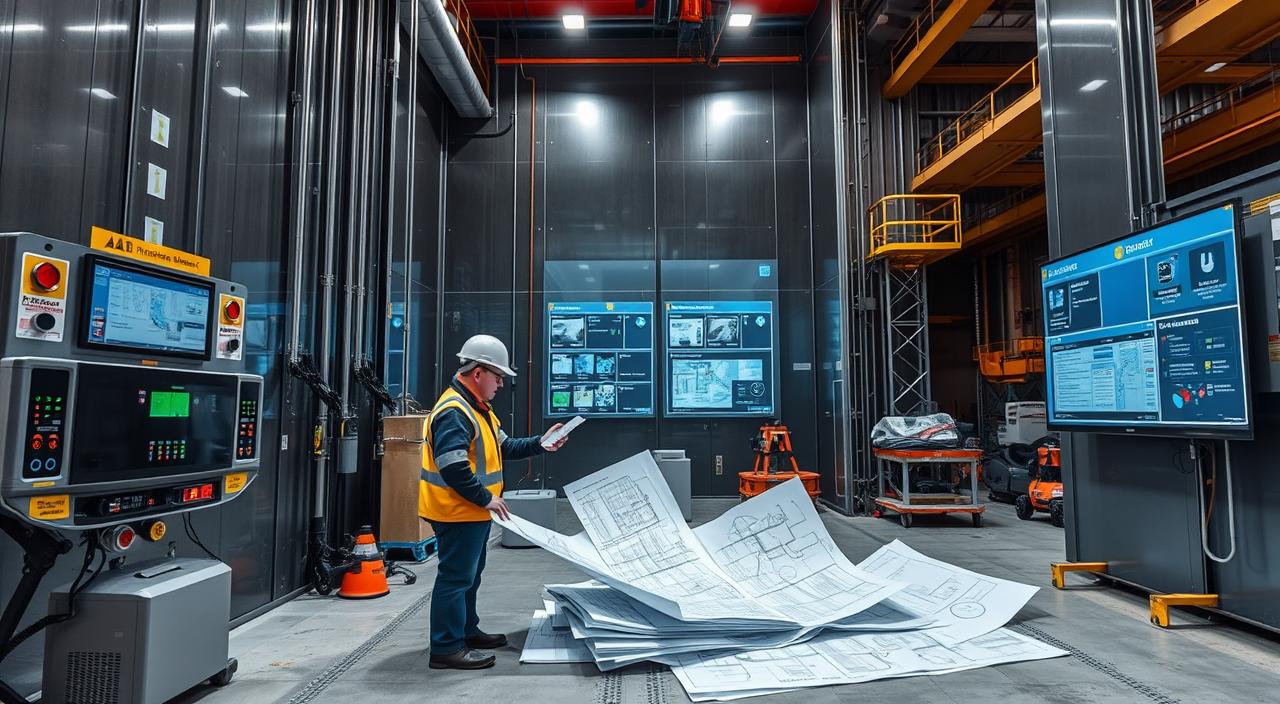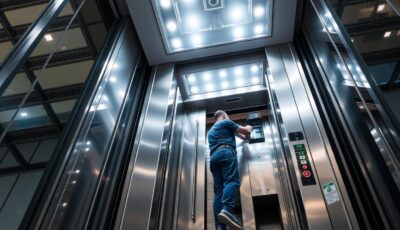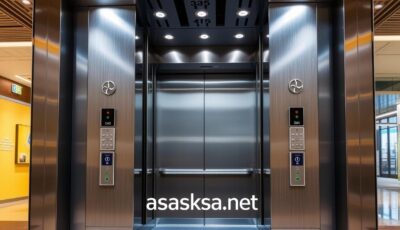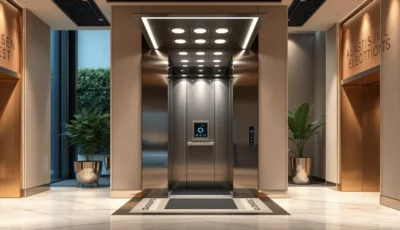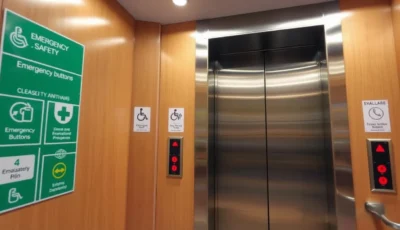Ever thought about how some places get fancy elevators without spending a lot? Installing elevators is key for modern buildings, making life easier for everyone. But, it can be pricey. We’ll look at ways to save money on elevator installations. This is good for property owners, managers, and businesses in Saudi Arabia.
محتوي المقالة
- 1 Understanding the Importance of Elevator Installation
- 2 Evaluating Your Budget for Elevator Installation
- 3 Choosing the Right Type of Elevator
- 4 Hiring a Qualified Elevator Installation Contractor
- 5 Benefits of Professional Elevator Installation Services
- 6 Maximizing Value with Cost-Effective Design Upgrades
- 7 Streamlining Costs Through Off-Site Fabrication
- 8 Implementing Preventive Maintenance Programs
- 9 Elevator Installation Best Practices for Commercial Properties
- 10 Conclusion
- 11 FAQ
- 11.1 What are the benefits of installing an elevator in my property?
- 11.2 How can I evaluate my budget for elevator installation?
- 11.3 What type of elevator should I choose for my building?
- 11.4 Why is it important to hire a qualified elevator installation contractor?
- 11.5 What advantages do professional elevator installation services offer?
- 11.6 How can I maximize the value of my elevator installation through design upgrades?
- 11.7 What is off-site fabrication and how does it reduce installation costs?
- 11.8 How does preventive maintenance help with my elevator system?
- 11.9 What are the best practices for elevator installation in commercial properties?
Key Takeaways
- Knowing the costs of different elevators can save you a lot.
- Checking your budget first helps pick the best options.
- Energy-saving elevators might cost more upfront but save money in the long run.
- Getting help from experts can avoid future repair costs.
- Planning elevator installs during building saves money on later changes.
Understanding the Importance of Elevator Installation
Elevator installation is key in modern buildings. They carry 325 million people daily, making them crucial for access and satisfaction. A well-installed elevator boosts a building’s value and function.
Ensuring elevators are installed safely is vital. Each area has its own rules for elevator installation. Following these rules keeps users safe and owners legal. Plus, using energy-saving tech can cut costs and show the value of elevators.
Designing elevators for everyone is important. This means making them wheelchair-friendly and adding sounds for those who are deaf or hard of hearing. Doing this not only meets legal standards but also makes the property more welcoming.

Choosing quality for elevator installation also improves the building’s look. Options like custom finishes and glass panels can make a big difference. Working with experts ensures everything is done right, benefiting both developers and tenants.
Evaluating Your Budget for Elevator Installation
The first step in evaluating budget for elevator installation is to list all costs. Elevator prices vary based on design, type, and project details. Residential elevators cost between $15,000 and $60,000. Commercial ones might cost over $100,000.

Having a clear budget is key for elevator project budgeting. It lets property managers talk to elevator companies. This ensures the chosen options fit within their budget. An itemized estimate helps focus on what’s most important without spending too much.
Don’t forget about extra costs after installation. These include permits, inspections, and maintenance. You might also need to pay for engineering studies and site prep. Electrical upgrades can add to the cost too. Keeping track of these helps with better financial planning.
Planning early can save money. Talking to contractors early and getting quotes can lead to discounts. It’s important to think about both the initial cost and ongoing expenses. This ensures the elevator works well for a long time.
Choosing the Right Type of Elevator
Choosing the right elevator is key for saving money, improving function, and boosting efficiency in any building. Knowing about the different types of elevators helps property managers make smart choices. These choices should fit both the building’s needs and the budget.
Hydraulic vs. Traction Elevators
Hydraulic elevators are common in low-rise buildings, from 2 to 8 stories. They use an electric motor to push fluid into a cylinder, lifting the car at up to 200 feet per minute. Their lower installation costs make them popular among owners.
Traction elevators, however, can go up to 2,000 feet per minute for taller buildings. They’re perfect for skyscrapers. Both types have their own benefits, depending on the building’s height and design.
The Importance of Energy Efficiency
Energy-efficient elevators use the latest tech like LED lights and regenerative drives. These features cut down energy use, saving money over time. They also help meet green goals and improve tenant satisfaction.
Property managers should look into custom elevator solutions. This way, they can enhance both user experience and financial gains.

Hiring a Qualified Elevator Installation Contractor
Choosing the right elevator installation contractor is crucial for a successful project. They ensure your elevator meets safety standards and avoid future maintenance issues. Look for a professional elevator company by checking their experience, customer feedback, and licenses.
Here are some key factors to consider when hiring an elevator installation contractor:
- Experience and Reputation: A seasoned contractor has a history of reliable service and quality work.
- Licensing and Insurance: Make sure the contractor has the right licenses and insurance to protect your investment.
- Customer Testimonials: Reviews from past clients offer insights into the contractor’s service quality.
- Project Management: A good contractor will manage your project well, ensuring it’s done on time and efficiently.
Choosing the right contractor for elevator installation improves your building’s accessibility and convenience. Professional elevator services add value to properties and keep up with modern trends. This includes smart building solutions that benefit everyone.
Benefits of Professional Elevator Installation Services
Choosing professional elevator installation services brings many advantages. These services ensure quality and performance. They also improve accessibility for people with mobility issues.
Quality Assurance in Elevator Installation
Specialized companies follow strict standards for elevator installation. They perform safety checks and inspections during the process. This ensures the elevator is safe and works well.
They also test and certify the elevator. This makes sure it meets all the necessary rules and works perfectly.
The Role of an Experienced Installation Company
An experienced elevator installation company makes the process smooth and efficient. They handle everything from the first assessment to the final installation. They work closely with architects and engineers.
Thanks to their knowledge, they avoid expensive mistakes. They also have good relationships with manufacturers. This means they can get the right parts quickly. Building owners can trust that their elevators will work well.
Maximizing Value with Cost-Effective Design Upgrades
Investing in cost-effective design upgrades can really boost the value of elevator installations. Paying attention to detail in material selection and aesthetic choices improves the user experience. It also promotes safety and functionality.
Choosing Durable Materials for Elevators
Choosing durable materials for elevators is key to saving on maintenance costs over time. Quality materials help elevators handle heavy use better, making them last longer. This choice not only boosts safety but also cuts down on expensive repairs, making it a wise investment.
Balancing Aesthetics and Functionality
Creating a balance between aesthetics and functionality in elevator design can make a building more appealing. Upgrading elevator interiors thoughtfully can attract tenants and improve the atmosphere without breaking the bank. Combining beauty with practicality makes the space welcoming for everyone.
Streamlining Costs Through Off-Site Fabrication
Off-site fabrication for elevators brings many benefits. It makes the process more efficient and cost-effective. This method allows for precise manufacturing, leading to better quality and less waste.
Looking at cost-saving strategies for elevator installation, off-site assembly reduces on-site disruptions. It makes projects run smoother because parts are made in controlled areas. This leads to safer and higher-quality work. For example, TK Elevator’s MiLift® service was made to tackle time and cost issues in Hong Kong and Mainland China.
Using modular construction speeds up projects. It lets elevator modules be put together on-site. This method cuts down on labor costs and lowers risks of on-site work.
- Reduction in overall carbon footprint due to streamlined operations.
- Less noise and air pollution during construction, particularly beneficial in urban settings.
- Increased reliability through rigorous quality checks during fabrication.
- Flexibility for future modifications, enabling easy disassembly and relocation.
Choosing off-site fabrication for elevators speeds up delivery and ensures safety. It’s a smart choice for efficient and green construction.
Implementing Preventive Maintenance Programs
Preventive maintenance for elevators makes them more reliable and last longer. Building managers can save money by avoiding costly repairs. A good plan includes regular checks to catch small problems before they get big.
Regular Inspections and Their Importance
Regular checks are key to keeping elevators safe and working well. They help spot wear and tear early, preventing big problems. It’s important to include tests, cleanings, and adjustments in the maintenance routine.
A detailed plan should cover what to check, how often, and the standards to follow. This ensures everything is done right and on schedule.
Training for Staff and Tenants
Teaching staff and tenants how to use elevators properly helps them last longer. Knowing how to use elevators and what to do in emergencies reduces accidents. This makes everyone safer and helps save money on maintenance.
Elevator Installation Best Practices for Commercial Properties
Effective elevator installation is key for commercial properties. A good plan is the first step. It makes sure the technology fits the building’s needs. The cost can range from $175,000 to over $550,000 per unit, so a detailed budget is crucial.
Following local building codes and safety rules is vital. These rules, like ASME A17.1, show the owner’s commitment to maintenance. Regular checks also reduce downtime and prevent lost revenue.
Choosing the right elevator depends on several factors:
- Building size and architecture
- Average number of users and traffic flow
- Energy efficiency considerations
- Customization and aesthetic integration requirements
Traction elevators are best for tall buildings, while hydraulic ones work for smaller ones. Good communication with all involved ensures everyone knows what to expect. Safety features like emergency stops and safety brakes are also important.
Conclusion
Effective elevator installation strategies are key for multi-story buildings. They improve functionality and safety. By carefully planning the budget and choosing the right elevator, managers can make their buildings better.
Managing elevator costs means picking the right contractors and regular maintenance. This keeps elevators working well for longer. It also ensures they are always ready to use.
Managers face challenges like poor training and hard-to-find parts. But, following safety codes and keeping maintenance records helps. This makes tenants happier and operations smoother.
Elevators are now crucial for accessibility and inclusivity. Good management is more important than ever. By focusing on installation and maintenance, managers can offer a safe and efficient ride for everyone.
FAQ
What are the benefits of installing an elevator in my property?
Elevators make moving around easier for everyone. They also boost your property’s value and make tenants happier. Plus, they help move goods around and follow building codes, which is key in Saudi Arabia’s real estate market.
How can I evaluate my budget for elevator installation?
Start by listing all costs for elevator installation, like design and setup. Decide on a budget and talk about it with your chosen installer. Ask for a detailed estimate to help you decide what’s most important.
What type of elevator should I choose for my building?
Choose between hydraulic and traction elevators based on your building’s height and needs. Hydraulic elevators are good for low-rise buildings because they’re cheaper. Traction elevators are faster and use less energy, great for taller buildings. Talking to experts can help you choose the right one.
Why is it important to hire a qualified elevator installation contractor?
A skilled installer ensures your elevator is safe and works well. They also save you from future problems and improve the installation quality. Look at their experience, licenses, and customer reviews to find the best installer.
What advantages do professional elevator installation services offer?
Professional installers guarantee quality, solve problems quickly, and get parts from manufacturers. These benefits avoid costly mistakes and delays, making your project successful.
How can I maximize the value of my elevator installation through design upgrades?
Choose durable materials for cost-effective upgrades. This reduces upkeep and boosts safety. Balance looks and function in your upgrades to improve your building’s appeal without spending too much.
What is off-site fabrication and how does it reduce installation costs?
Off-site fabrication makes parts in a controlled setting, improving precision and cutting waste. This method reduces site disruption and costs, speeding up your project and saving on labor.
How does preventive maintenance help with my elevator system?
Preventive maintenance extends your elevator’s life and saves money in the long run. Regular checks catch small problems early. Training staff and tenants on proper use also helps, keeping your system safe and efficient.
What are the best practices for elevator installation in commercial properties?
For commercial elevator installation, plan well, follow building codes, and pick technology that meets your needs. Make sure your elevator is accessible and safe, creating a smooth vertical transport system.

